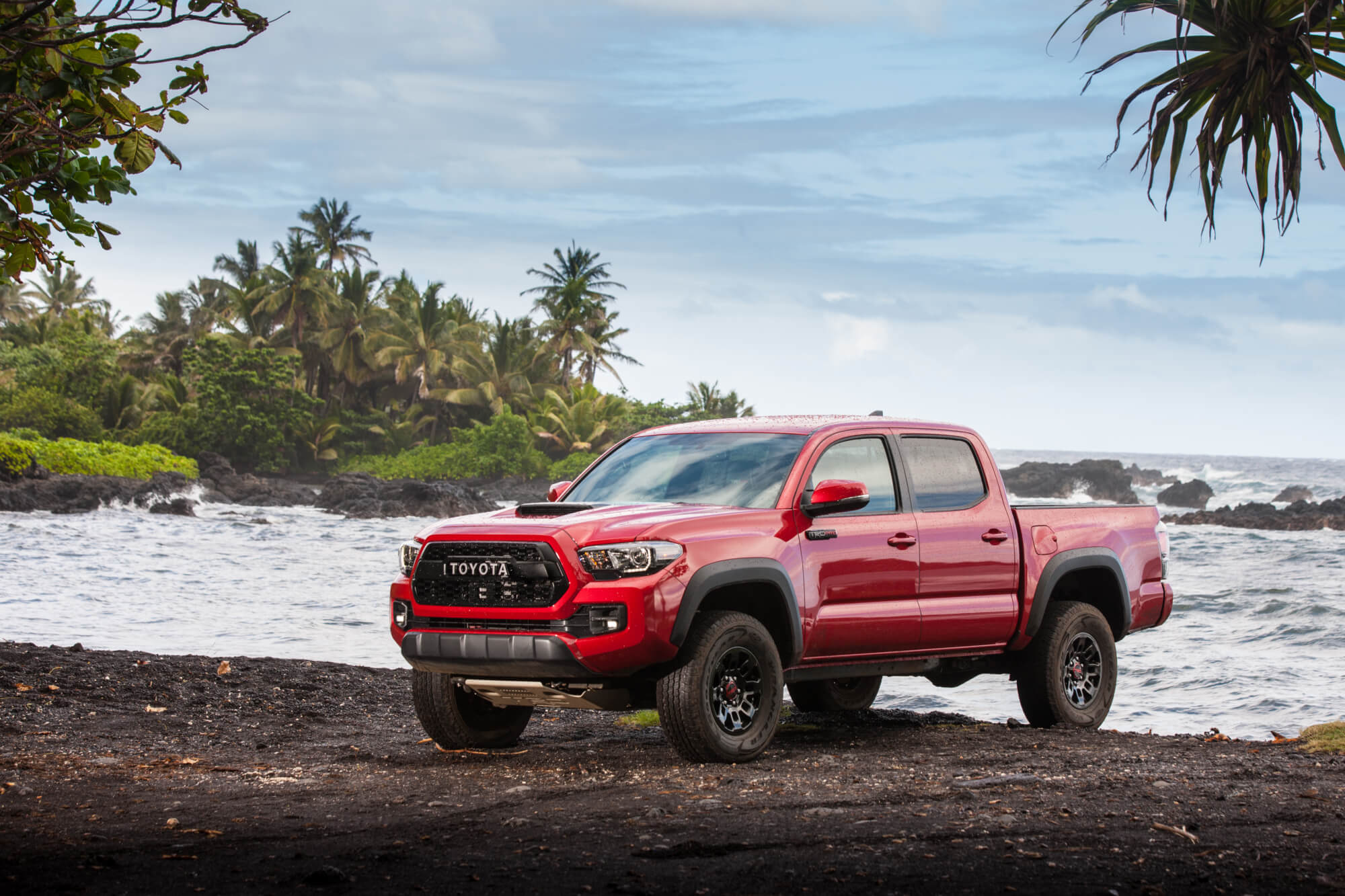
No other truck manufacturer has had a long-standing commitment to small pickup off-road capability like Toyota. It all started in 1979 when the company launched the world’s first compact 4WD pickup. Thanks to backcountry and Baja race experience, Toyota’s trucks remained the most capable in their class as the competitors and the decades came and went.
In 1997 Toyota added a very special option for its new Tacoma – the Toyota Racing Development (TRD) Off-Road package. This wasn’t just a fancy sticker package. The TRD equipment was serious stuff and included an electronically locking rear differential, Bilstein shocks, better tires, and a healthy skid plate up front. It worked very well and became one of the most popular off-road packages in history. The TRD Off-Road package set the stage for others to follow.
It’s been exactly 20 years since that package was introduced. The popularity of TRD’s products has only grown. Today, Toyota offers three different TRD-branded trim levels for the newly-redesigned Tacoma: TRD Sport, TRD Off-Road, and the most recent addition, the second-generation TRD Pro. The last TRD Pro Tacoma lasted just one model year (2015) and was not only a hit for Toyota but an excellent factory-built dirt machine, too. No surprise that when the all-new Tacoma arrived for 2016, a second-generation Pro would be right behind it.
The new TRD Pro is here and we borrowed a Super White $43,700 Double Cab short bed (the only way they come) for a week worth of testing in Southern California. Of course, a part of that testing involved our standard 300-mile mix of city and highway driving, as well as a few hours (actually more than a few in this particular truck) getting dirty on the trails around Hungry Valley SVRA in Gorman. So how does the new Taco Pro measure up? Let’s find out.
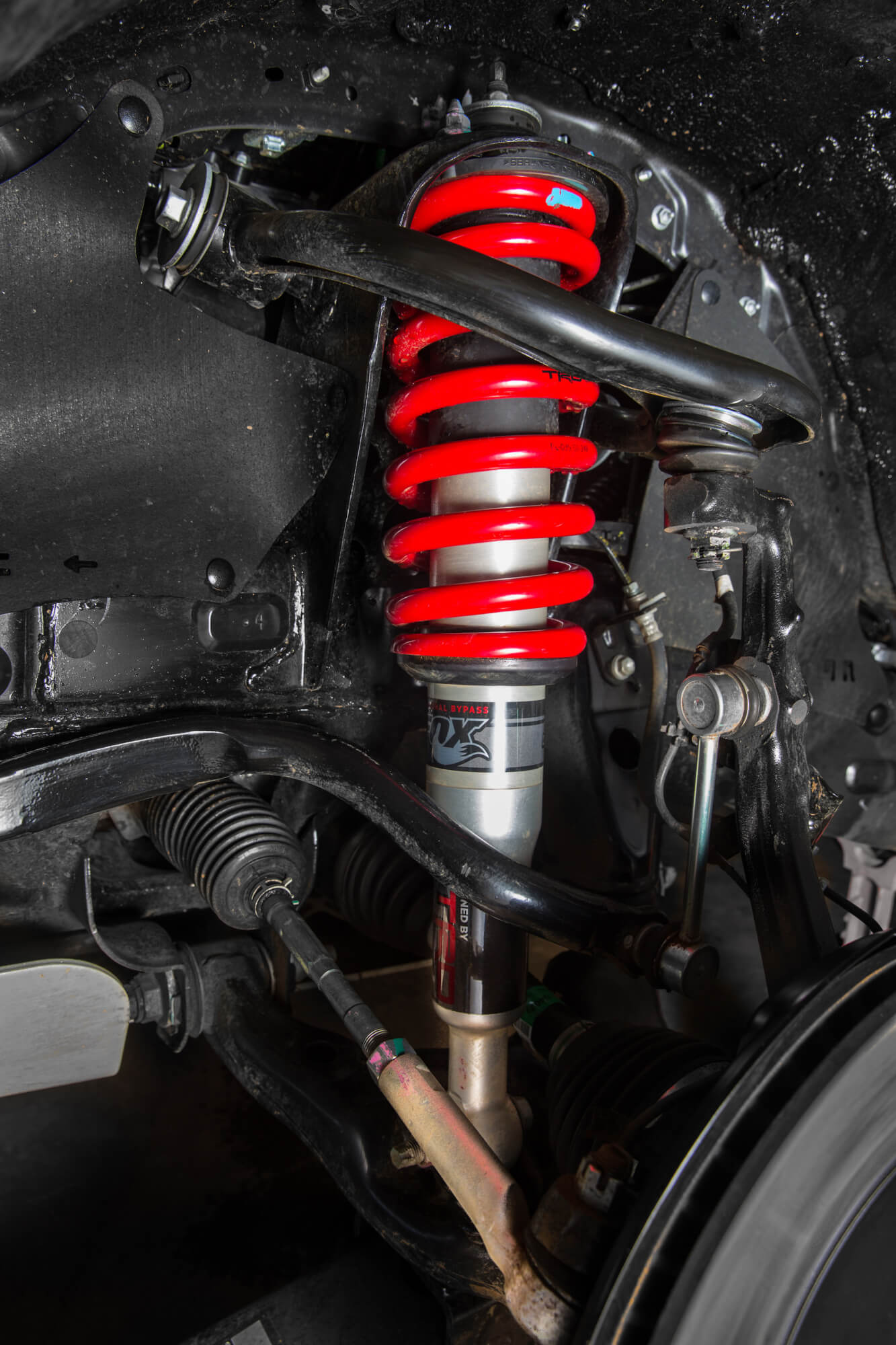
The TRD package includes a huge ¼-inch aluminum skidplate that protects the 8-inch differential. But the heart of this package is the softer, 1-inch taller coil springs, and the 2.5-inch Fox Racing shocks. Because of the softer suspension with 0.7-inch more travel, the TRD Pro Tacoma uses a slightly larger swaybar to help control body lean.
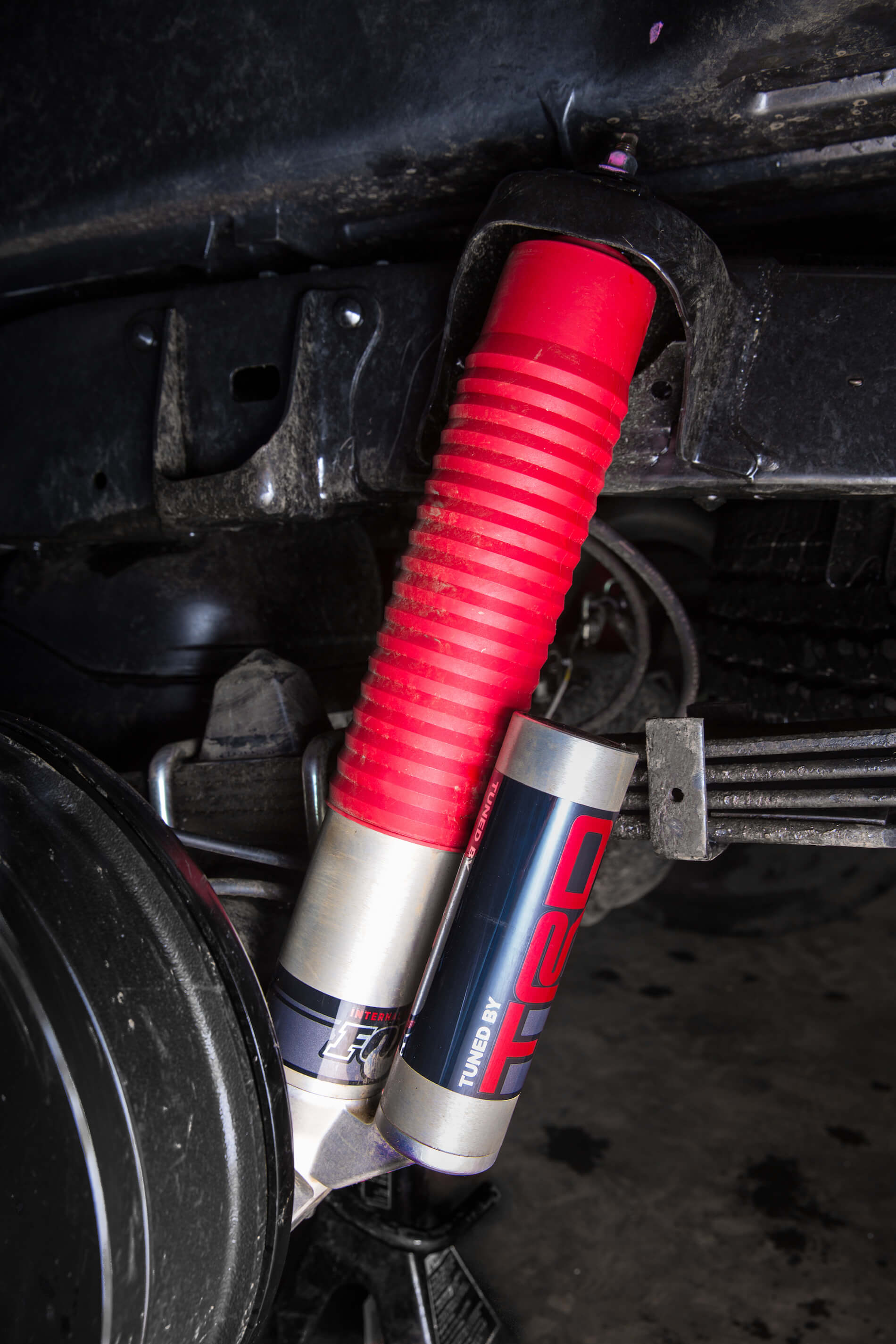
The Hardware
The development engineers responsible for the new TRD Pro Tacoma had an ace up their sleeve – current owners. They spent time finding out what the folks who bought the last TRD Pro truck liked about their rigs. According to TRD Performance Parts manager Jakin Wilson, these guys didn’t want another level up in terms of capability. They weren’t looking for a “mini Raptor.” The vast majority used their trucks daily. So, they requested better on-road shock control and isolation. Translation? Refinement. In terms of off-road use, the group mentioned that they wanted improved isolation from small rocks, as well as more weight to the steering feel when driving in the dirt.
Wilson mentioned they spent time at Toyota’s Arizona Proving Grounds to nail down the on-road driving characteristics. The team evaluated a lineup of tire choices and settled on the Goodyear All-Terrain Adventure with Kevlar for its combination of puncture resistance and quiet on-road demeanor. Of course, this tire is noticeably less aggressive than the old BFG All-Terrain K/Os. The tire size, 265/70R16, is the same used on other TRD Off-Road package trucks. Wilson said the wheels have 13mm more offset for a wider track. He explained that while there is room for a larger tire, the team simply didn’t want to compromise for the mass, fuel economy, and noise penalties of larger tires.
The key to the TRD Pro truck’s performance has always been the suspension. The formula is the same this time around, if slightly less aggressive. The coil springs up front are 1 inch taller than those on a regular production Tacoma. Suspension travel in the rebound direction has increased by 0.7 inch. The spring rates have been softened by 15-20% too, according to Wilson.
Instead of using Bilstein shocks of the previous-generation trucks, TRD selected Fox as the supplier this time around, using Fox’s 2.5-inch diameter “Internal Bypass Zone” shocks. Wilson says this allows the shocks to be soft for daily driving. But the damping force increases significantly as the shock reaches the end of the stroke for bottoming resistance. In the rear, Wilson says the springs provide no lift but are unique and use a progressive rate. TRD uses Fox racing shocks at the rear of the Tacoma as well, with a piggyback reservoir. Wheel travel is increased in the rear by 0.8 inch. To help maintain body control with the softer suspension, engineers increased the diameter of the front swaybar from 28 to 30mm. All that allows the Pro to boast an approach angle of 35 degrees (3 degrees improved over a TRD Off-Road), and a departure angle of 26 degrees (2.5 degrees up from the TRD Off-Road). Impressive.
Toyota drivetrains are fairly beefy from the factory, so the team retained the 8-inch IFS front differential, and 8.7-inch rear solid axle. Six-speed manual trucks use 4.30:1 axle gears, and TRD Pro Tacomas with a six-speed automatic like ours have 3.90:1 gears. No matter what transmission is selected, every Pro truck uses Toyota’s electronically locking rear differential as well as the standard transfer case with a 2.57:1 low range.
Under the hood of every Tacoma TRD Pro is the company’s sophisticated 3.5L V6 that generates 278 horsepower, and can switch between port and direct fuel injection. To boost the aural qualities of this engine, TRD developed a new stainless-steel cat-back exhaust system specifically for the new Pro.
At our local scales, the TRD Pro weighed exactly 4,600 lbs. That’s 40 pounds more than the last TRD Off-Road Tacoma we tested. But the payload (1,000 lbs.) as well as the towing capacity (6,400 lbs.) is the same as that TRD Off-Road package Double Cab 4WD truck we previously spent time in.
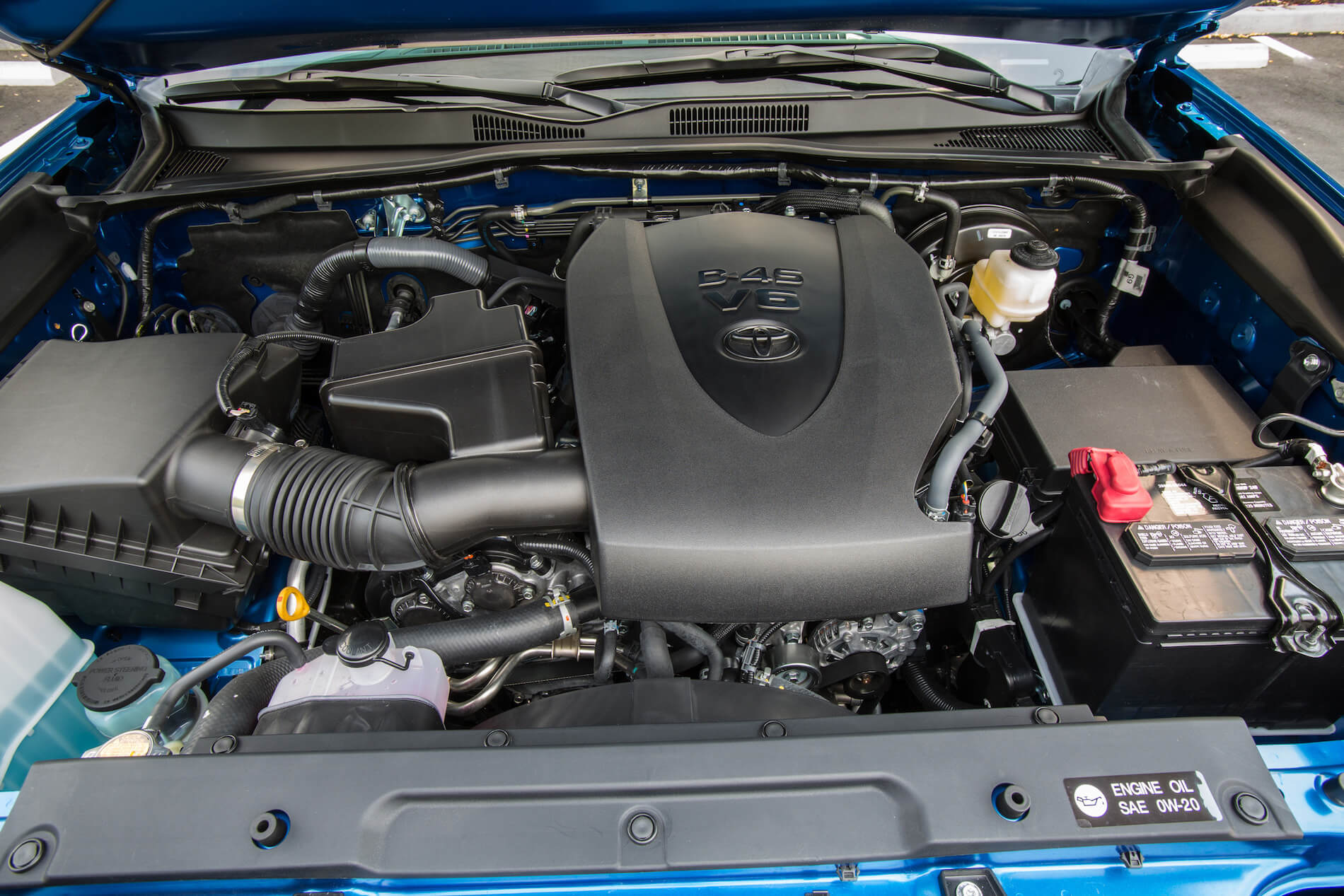
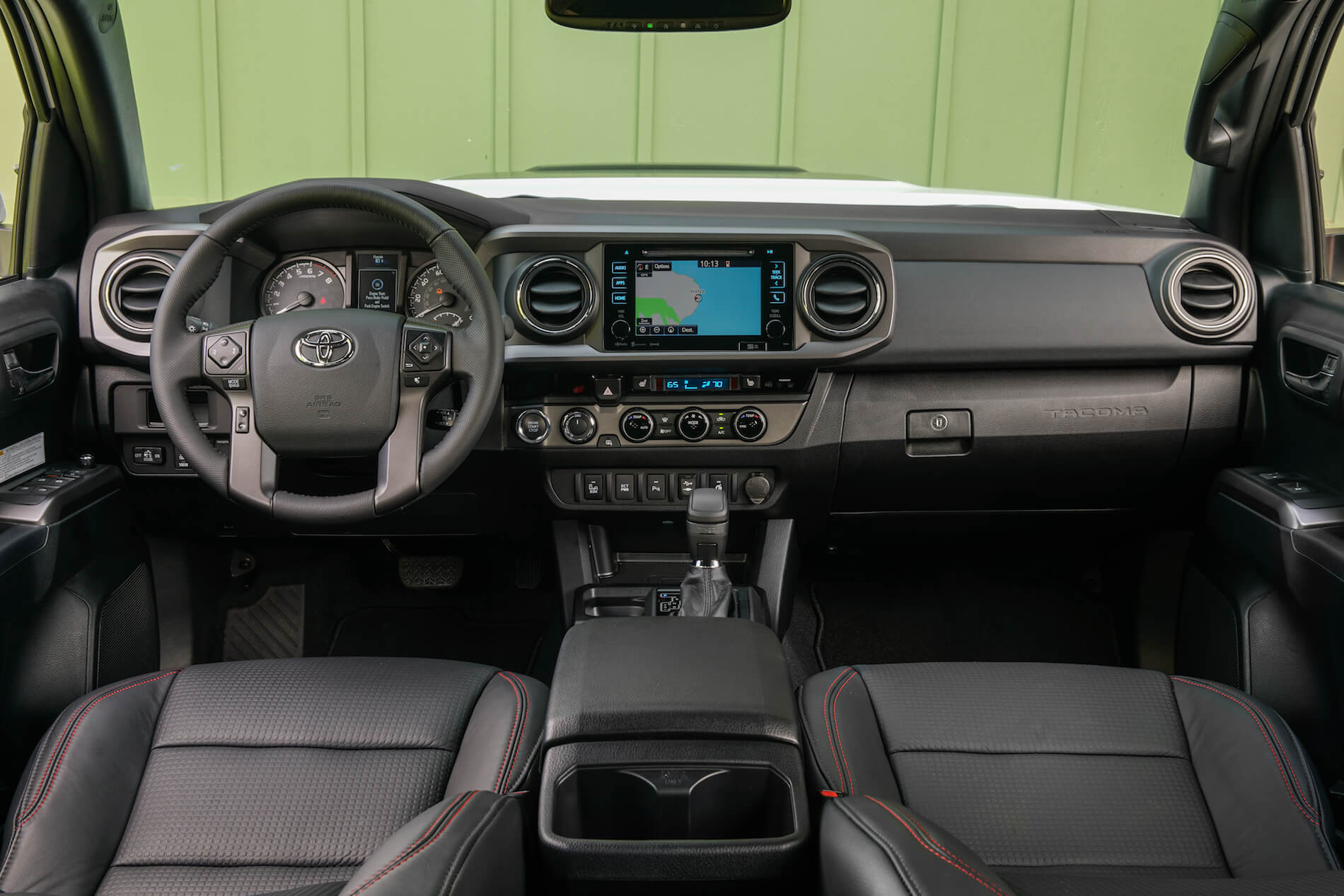
On The Street
The TRD Pro looks aggressive and chiseled. There’s no getting around that. The styling is just about perfect to our eye. In fact, this truck drew compliments from admiring bystanders like no other 4X4 we’ve had this year. Southern California simply digs this tough-looking Tacoma. That old-school “Toyota” lettering across the grill, as well as the two-mode Rigid LED fog lights really add to the truck’s vibe.
Anyone familiar with the latest-generation Tacoma will find the world inside very familiar. Heated leather seating comes standard and those seats are embroidered with the TRD Pro logo. There’s a TRD shifter and floor mats to set it apart. It’s a simple interior. Honestly, it could use some special dash badging or contrasting color materials to make it feel a little more special compared to all the other Tacomas. Still, this is a comfy truck.
The 3.5L V6 is quite a strong motor when revved. But it doesn’t provide a great deal of low-end torque. After all, peak torque happens all the way up at 4,600 rpm. Because the transmission always wants to upshift to the next highest gear to save fuel, that results in quite a bit of hunting to find the right gear under light throttle. The transmission’s Sport mode locks out the overdrive gears and wakes the experience up somewhat. However, we found that mode could certainly be calibrated more aggressively for this model. In other words, to get reasonable acceleration out of this Tacoma, the driver really needs to lay into the throttle.
The TRD exhaust sounds mellower than expected. That’s a good thing. To our ear, a typical aftermarket cat-back system can be a bit too much sometimes. But after 300 miles, the sound was always pleasant and never irritating.
The suspension feels great on the street. The calibration is cushy and easily swallows big bumps and potholes. We never really noticed that the steering was any heavier. On the freeway, the ride is no harsher than a Tacoma with the normal TRD Off-Road package. The Pro exhibits the same slight amount of freeway hop we felt in the last Tacoma we tested. Because these tires have a less aggressive pattern than some all-terrains, they remained quiet on the highway. In other words, this more serious off-road gear never compromises street comfort – only enhances it.
The Tacoma revs right around 1,800 rpm at 70 mph. Because there isn’t much torque in the basement, the Pro will drop two gears on slight grades and rev right at 3,000 rpm at the same road speed. One might think that would clobber fuel economy, but as we found in the last Tacoma we tested, that’s not the case. The EPA rates our Pro at 18 mpg city and 23 mpg on the highway. On our test it returned 19.6 mpg. That’s slightly better than the last Tacoma we tested (18.9 mpg) but not quite as good as the last V6 Colorado we spent time in (20.7 mpg).
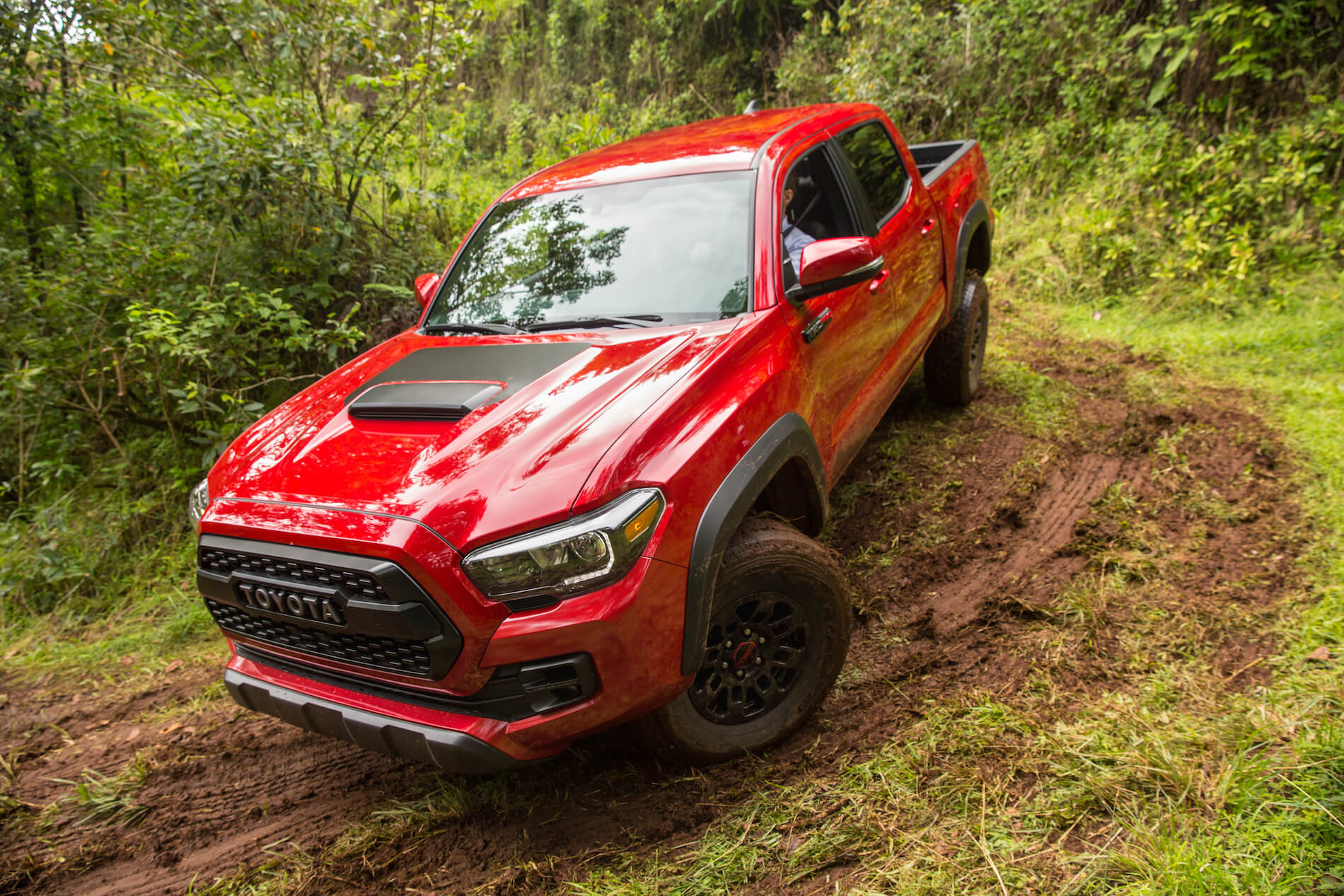
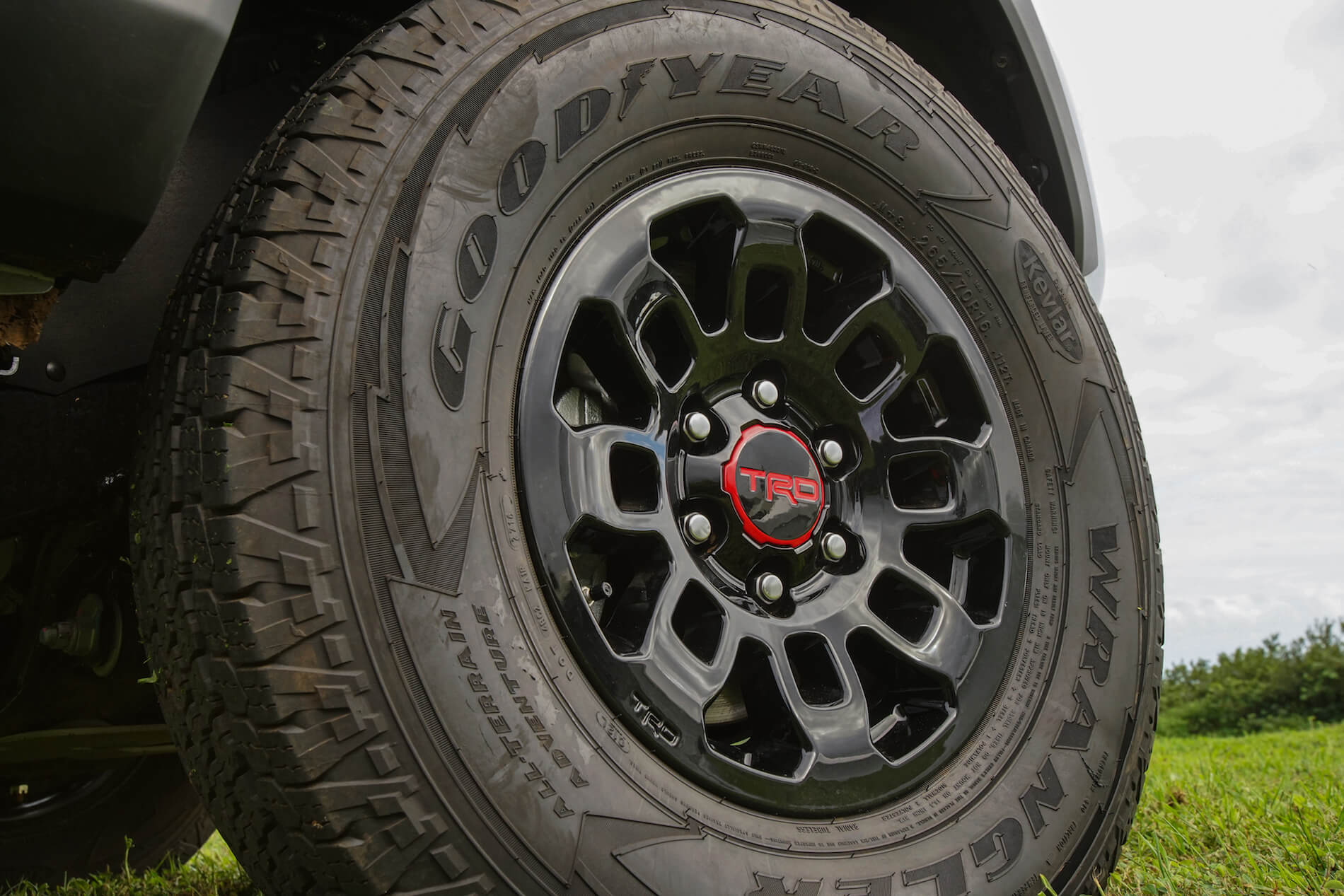
On The Trail
It’s hard not to fall for the TRD Pro’s charms in the dirt. It’s simply a wonderfully capable machine on both higher speed terrain and during slow-speed trailwork. We measured 9.5 inches under that massive front skidplate, and 9 inches under the rear diff. There just wasn’t a situation on the trails we explored where we needed more clearance. The Tacoma never came close to rubbing or scraping anything.
For such a capable truck, you’d think Toyota would engineer a better transfer case shifter. The rotary knob not only feels cheap and flimsy to use, but the system also takes a very long time to engage and disengage low range. It’s frustrating. But once it’s in low, the Pro can walk up some seriously rutted trail sections without a problem. The suspension has excellent articulation for a stock truck, and it takes some ferocious big rocks and ruts to get a tire off the ground. When it does, simply engage the Multi-Terrain system and pick the most aggressive mode for traction control (Rock) and the truck clamps down on wheelspin. Yes, this truck also has Toyota’s Crawl Control, which acts like a low-speed cruise control in the dirt. It certainly works, but if you enjoy four-wheeling, the system takes away much of the fun. In its slowest setting, it’s very abrupt in its management of the brakes, throttle, and traction control. However, we did use the system while backing down a very steep and rutted hill climb, and it made an easy descent out of a potentially sweaty-palm situation.
In a few instances when we needed more traction, that rear locker pulled us right up most of the trails we aimed the Tacoma’s nose toward. That said, a swap to more aggressive, large-diameter tires would likely allow us to try even more difficult trail sections. It’s an upgrade we’d make as soon as these tires wore down.
As good as the Pro is in slow-speed trailwork, it’s even better as the speed goes up. On one particular dirt trail, we were able to maintain 35-40 mph over ruts, bumps, and small whoops without bottoming the suspension or causing any white-knuckle moments. The ride was soft, with just a few kickups from the rear of the truck on the worst hits. It’s certainly not on the level of a Raptor, but most trucks we’ve tested have trouble maintaining even half that speed on this trail. It was the most fun we’ve had in the park in a long time.
When we moved on to the biggest whoops, the control was equally good. Only the TRD Pro 4Runner was able handle these same bumps at around the same speeds. It’s no surprise it worked so well. TRD’s Wilson said the team had three tuning sessions with Fox in the California desert that lasted 3-5 days each. “We’d take the shocks apart and they’d create a new part right there – like just in time manufacturing.”
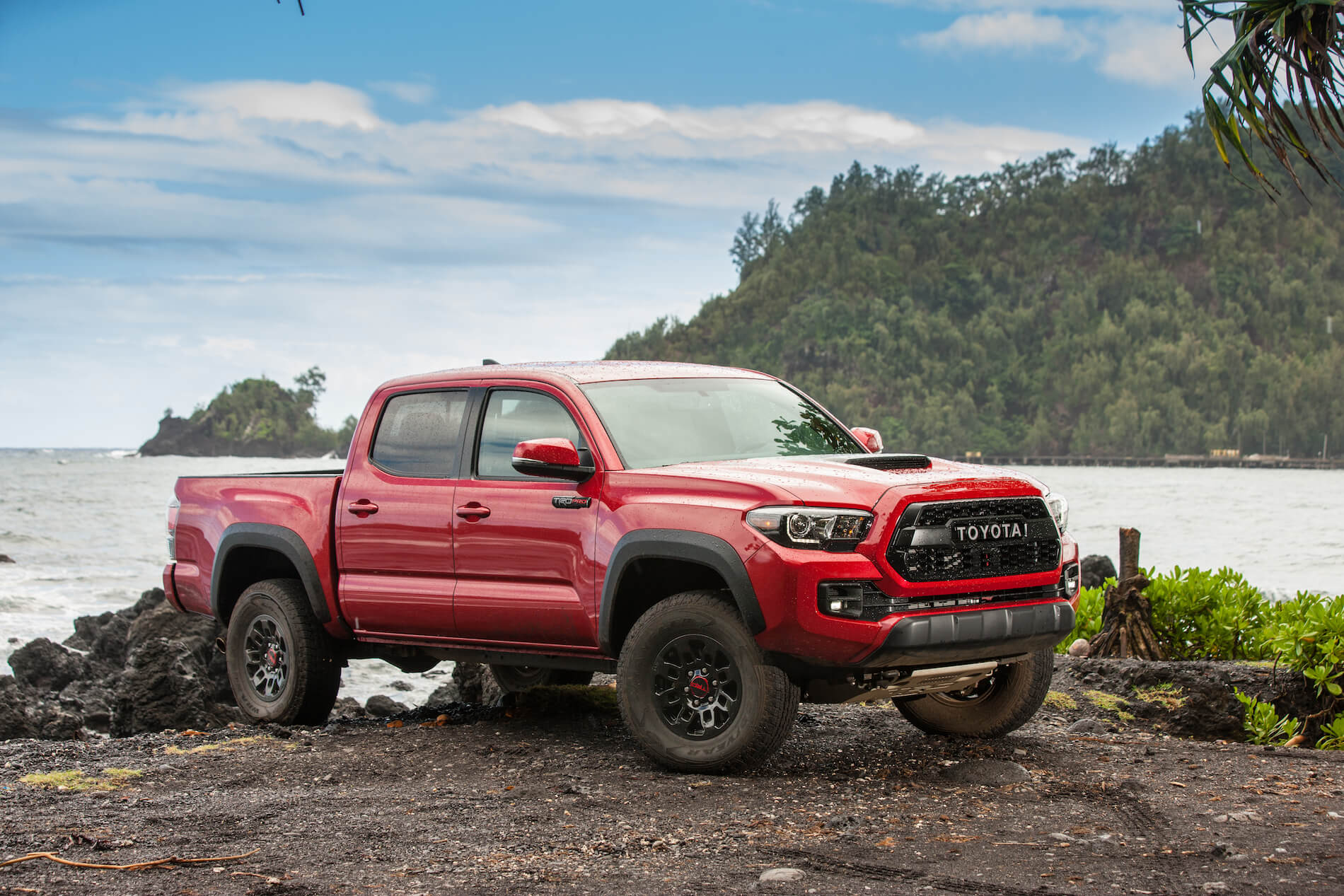
The Bottom Line
The TRD Pro Tacoma comes completely loaded from the factory. There are no options. Just pick your transmission and color: Cement, Super White, or Barcelona Red Metallic. At $43,700 the Pro isn’t cheap. However, you do get a lot of gear for that money. A TRD Off-Road Tacoma starts at just over $36,000. That’s a sweet deal. But when optioned with everything that came standard on our Pro truck, the price balloons to $39,890. Toyota lets you add the TRD Pro skidplate for $499, as well as the TRD exhaust for $799 to any Tacoma. Add them to a loaded TRD Off-Road truck and you’d have a TRD truck that cost almost $42,000. That’s very close to the price of the Pro. And that’s without the TRD Pro exclusive goodies, most notably that spectacular Fox suspension.
At this point, the TRD Pro Tacoma is still the most capable midsize truck – by a long shot. Of course, we know there’s a Chevy Colorado ZR2 that’s waiting right around the corner. A more aggressive Chevy could really challenge this Toyota. This is a great time to be an off-road enthusiast. We can’t wait for a faceoff.



2